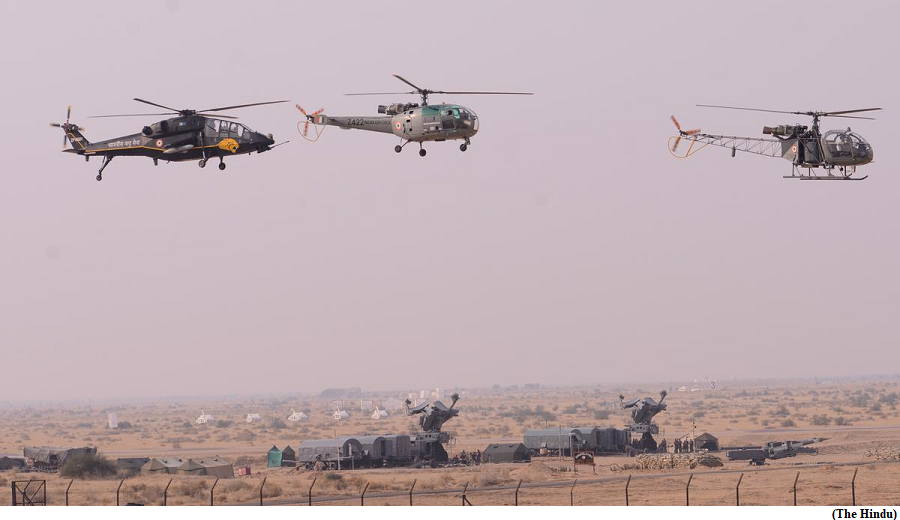Army to start phasing out Cheetah, Chetak helicopters from 2027 (GS Paper 3, Defence)

Why in news?
- The Army will start phasing out Cheetah and Chetak helicopters from 2027 on completion of their total technical life, as it looks to induct the indigenous light utility helicopters (LUHs) to replace them.
- The armed forces have been attempting to replace the Cheetah and Chetak helicopters for well over a decade.
New additions:
- In November 2021, the Defence Acquisition Council approved the procurement of 12 limited series production (LSP) variants of the LUH at a cost of around ₹1,500 crore, six each for the Army and the Air Force.
- The choppers have been designed and developed by Hindustan Aeronautics Ltd. (HAL), but the project was delayed due to issues with the autopilot.
- The six LSP LUHs are expected to be delivered to the Army between December 2024 and June 2025.
- The bigger contract for LUHs is expected to be concluded by January 2024 and deliveries expected by 2026 onwards.
- In the interim, the Army is also looking to lease 20 utility helicopters to address the shortage.
Current stock:
- The Army currently has 190 Cheetah, Chetak, and Cheetal helicopters of the original 246.
- Of these, at any given time, around 25 are at the HAL for maintenance, which is a deficiency of around 37% in this segment, the source said. Close to 130 of the 190 choppers are between 30 and 50 years old.
- Of the 190 Cheetah and Chetak in service, around 134 helicopters, or over 70%, are over 30 years old.
- In addition to the Army, the Navy and the Air Force operate these helicopters. For instance, the Air Force has around 120 Cheetah and Chetak helicopters and 18 of the more recent Cheetals.
- The light helicopter fleet is the lifeline in transporting supplies and for evacuations in high-altitude areas such as the Siachen glacier. The commitments on the northern borders have significantly gone up since the 2020 stand-off.
- The Army also operates around 145 indigenous advanced light helicopters (ALHs), 75 of which are the Rudra-weaponised variants. Another 25 ALH Mk-III are on order.
Focus on LUH:
- In all, the Army and the Air Force together have a requirement of over 400 helicopters of this class. The LUH is a 3-tonne class helicopter with glass cockpit for reconnaissance and surveillance roles and as a light transport helicopter.
- The helicopter will be capable of flying at 220 kmph, with a service ceiling of 6.5 km and a range of 350 km with 400 kg payload, according to the HAL.
To curb evasion, EU report calls for 2% global wealth tax on billionaires
(GS Paper 3, Economy)
Why in news?
- Recently, the European Union Tax Observatory released its ‘Global Tax Evasion Report 2024’.

Details:
- Pointing out that tax evasion is enabling billionaires to enjoy effective tax rates equivalent to 0% to 0.5% of their wealth, it has called for a global minimum tax on billionaires equal to 2% of their wealth.
- This would both address evasion and “generate nearly $250 billion from less than 3,000 individuals.
- The report justified the proposal by noting that while the number of taxpayers affected by it would be miniscule, the tax rate for them (2%) “would still be very modest” given that the wealth of billionaires has grown at 7% a year annually on average since 1995 (net of inflation).
Automatic exchange of bank information:
- Assessing the impact of international efforts made so far to curb tax evasion, it highlighted the success of the automatic exchange of bank information in reducing offshore tax evasion by a factor of three over the past 10 years.
- It observed that before this measure came into effect, “households owned the equivalent of 10% of world GDP in financial wealth in tax havens globally, the bulk of which was undeclared to tax authorities and belonged to high net worth individuals”.
Reasons for offshore tax evasion:
- It is still possible to own financial assets that escape being reported on because not all offshore financial institutions comply with the requirement of automatic exchange of bank information, for fear of losing their customer base while facing no real threat or penalty from foreign tax authorities for non-compliance.
- The wealthy individuals who used to hide financial assets in offshore banks have started shifting their holdings to asset classes not covered under this agreement, especially real estate.
- The report, therefore, calls for expanding the range of assets brought under the system of automatic exchange of information.
Gaps & loopholes:
- The other major measure, the global minimum tax of 15% on MNCs, adopted in 2012 by 140 countries and territories has been a disappointment. While it was expected to increase global tax revenues by 10%, a growing list of loopholes has reduced expected revenues by a factor of two.
- The report red-flagged the trend of “greenwashing the global minimum tax” wherein MNCs can use ‘green’ tax credits for low carbon transition to reduce their tax rates way below the minimum of 15%.
- The report also flags emerging forms of aggressive tax competition that are severely affecting government revenues.
- It notes with concern the rise of preferential tax regimes targeting wealthy foreign individuals, their number having grown from five to 28 in the EU and the U.K.



